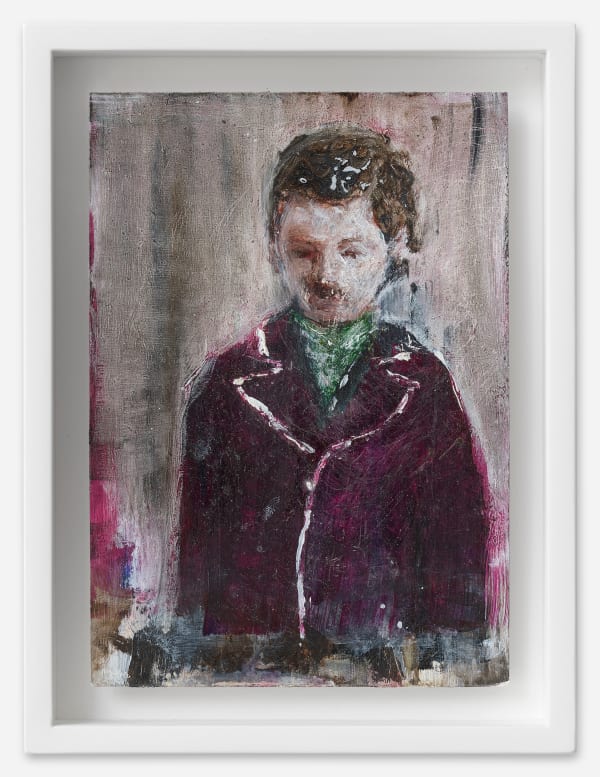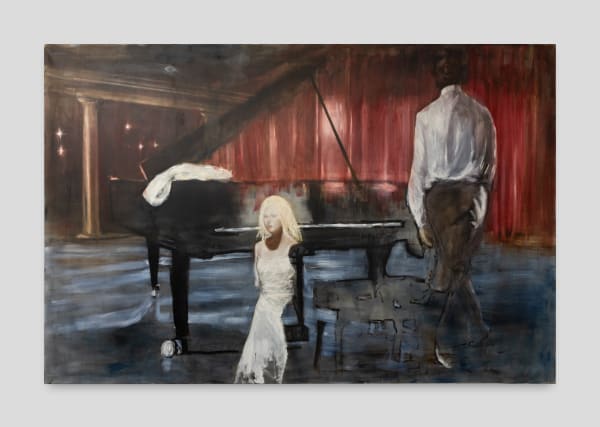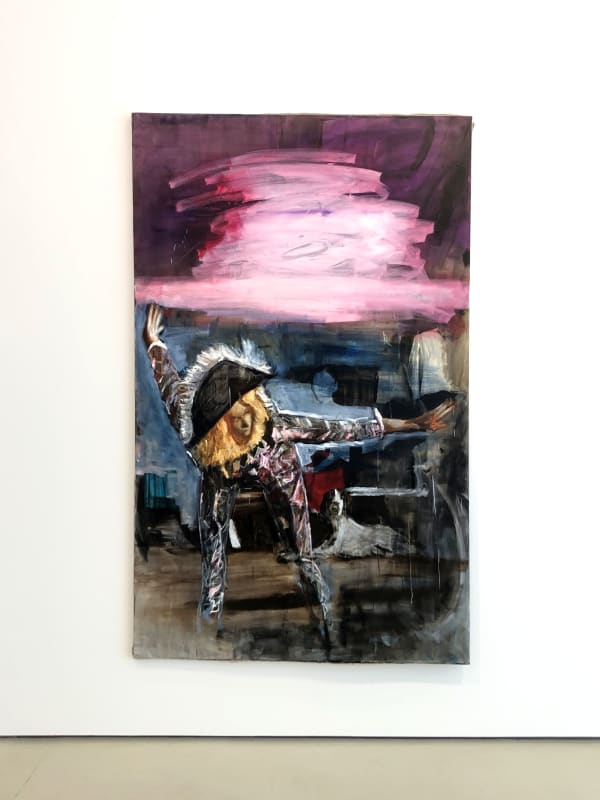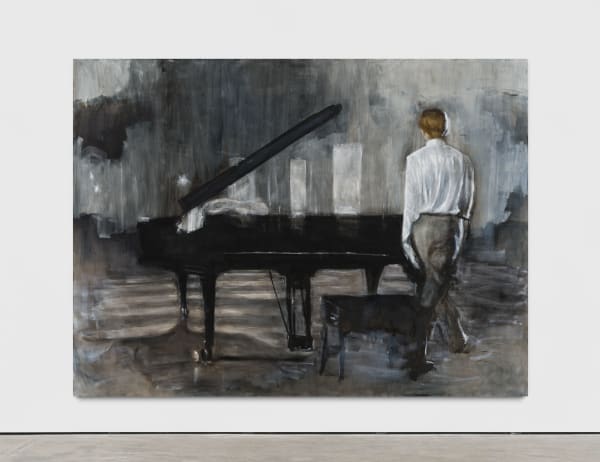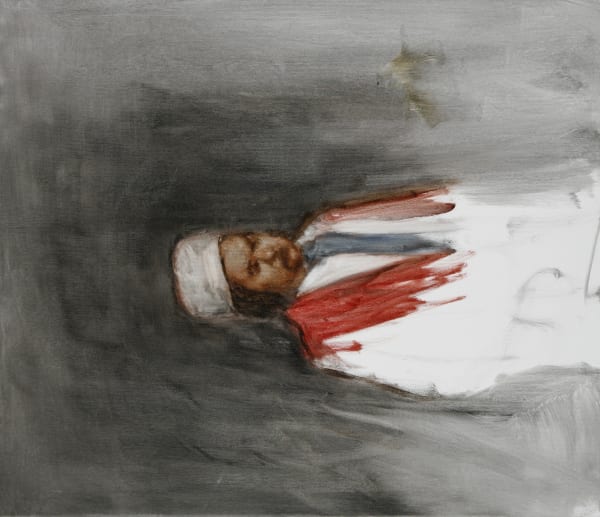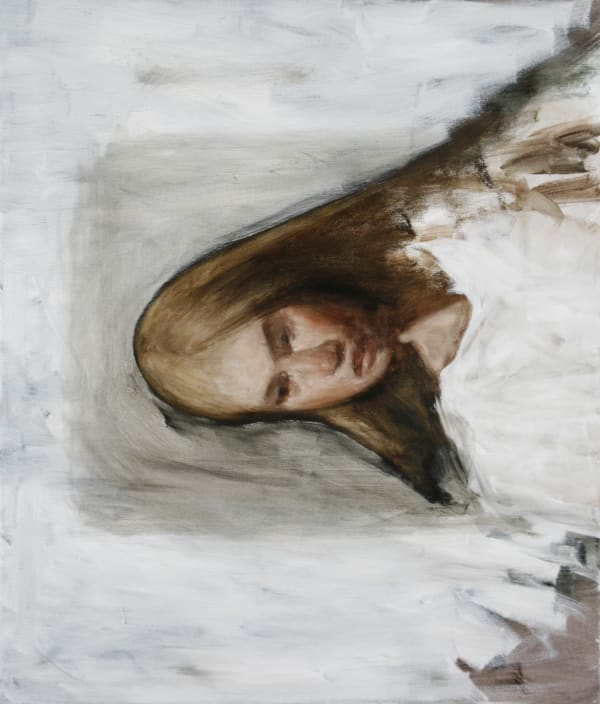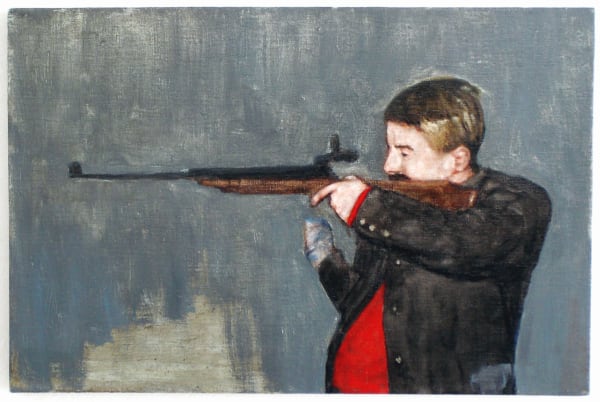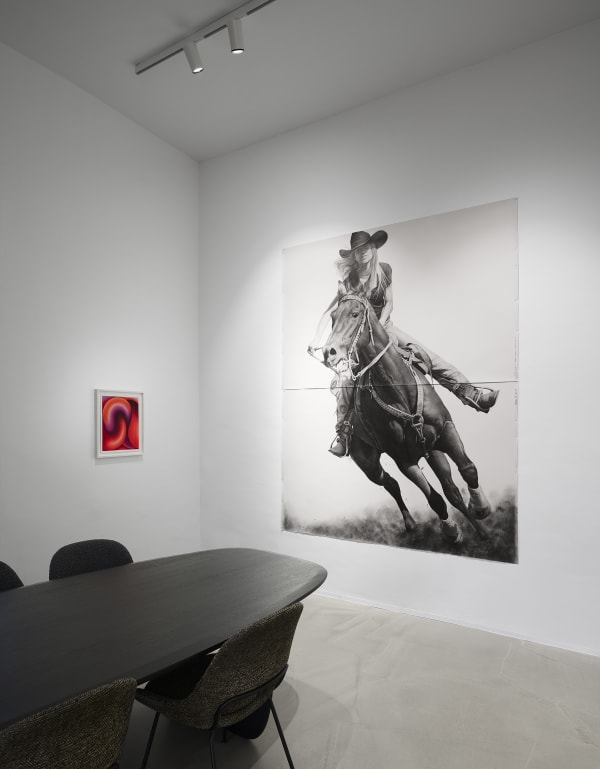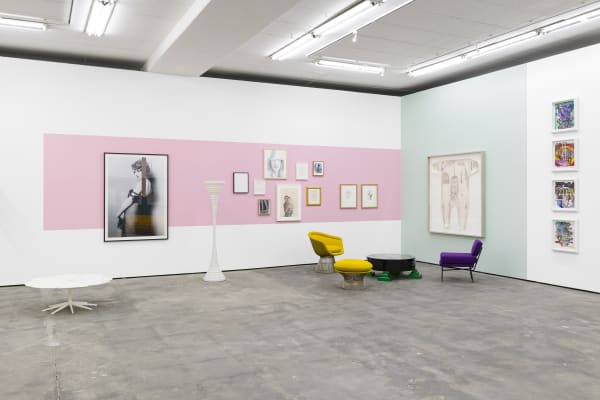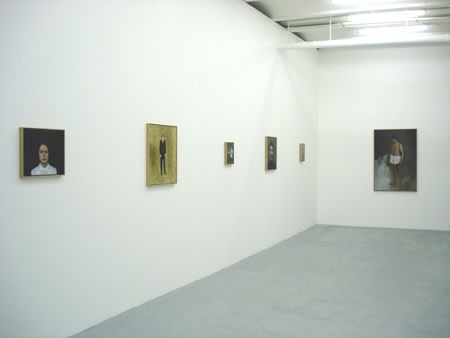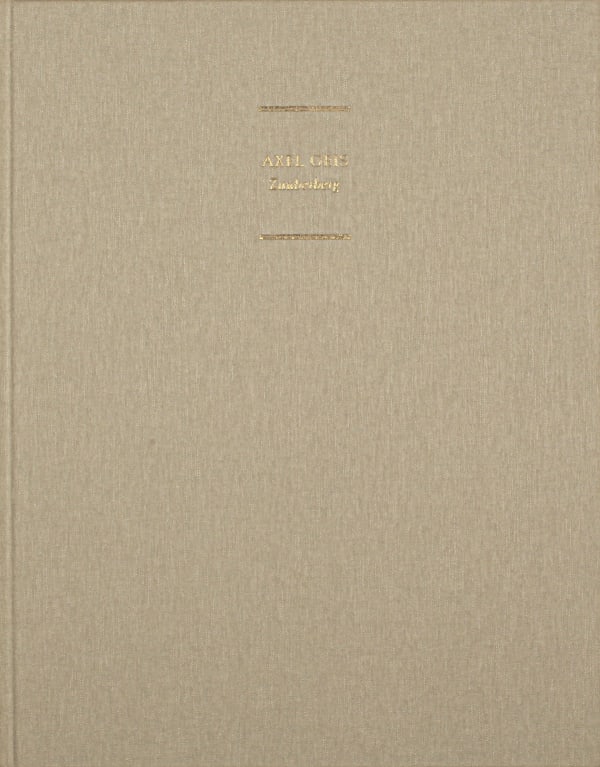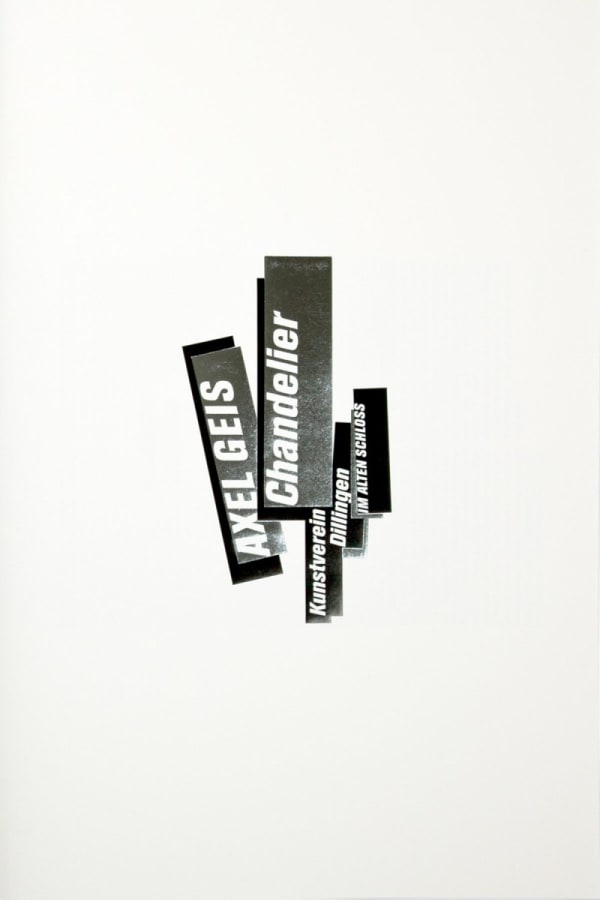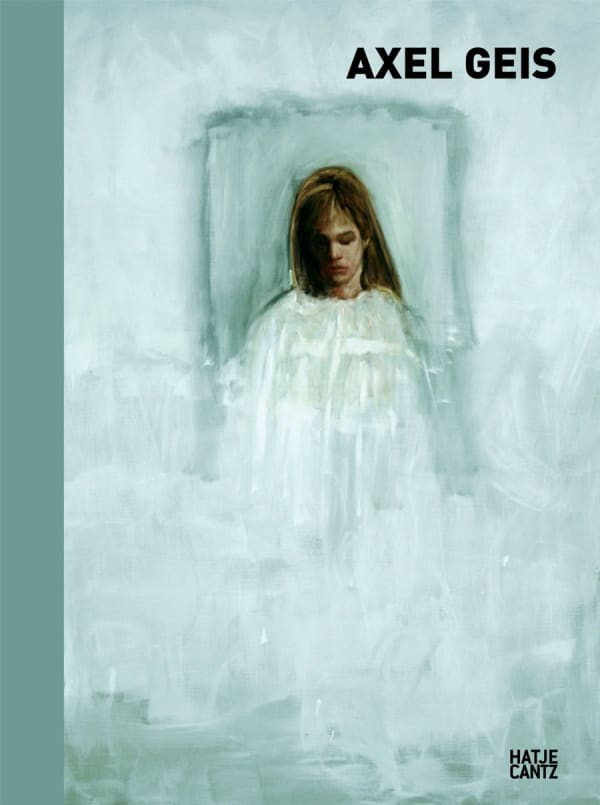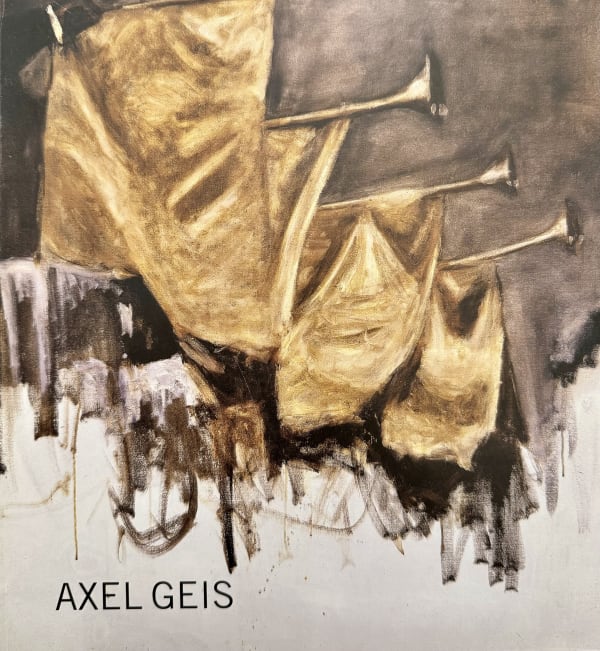Axel Geis b. 1970
Axel Geis (b. 1970, Limburg an der Lahn, Germany, lives and works in Berlin, Germany) is a figurative painter celebrated for the exceptional intimacy of his works. His paintings extensively reference 19th-century French and Spanish art historical traditions and themes. Geis creates his works from reproductions such as film stills, photographs, and images sourced online. His figures appear to float on the canvas, encircled by visible brushstrokes in muted or earthy tones, while frequently set against backgrounds that suggest an underlying sense of darkness and incompletion.
Axel Geis' has had numerous notable solo exhibitions, including Kunsthalle Mannheim; Kunstverein Dillingen and Kunstverein Trier. Geis has also participated in group exhibitions at Villa Schöningen, Potsdam; Künstlerhaus Palais Thurn und Taxis, Bregenz; Künstlerhaus Bethanien, Berlin; National Museum of Art, Bucharest; Arp Museum, Remagen; Centre Pomidou, Paris; Portland Art Museum and Margulies Collection at the Warehouse, Miami. The artist's works are held in the collections of the Centre Pompidou, Paris; Musée National d’Art Moderne, Paris; Florence and Daniel Guerlain Collection, Paris; Collection of Contemporary Art of the Federal German Government of Germany, Chemnitz; Kunsthalle Mannheim; Saarland Museum, Saarbrücken; Jil Sander Collection and Rubell Family Collection, Miami.
-
 Tancredi
Tancredi -
 Harlekin
Harlekin -
 Zhora
Zhora -
 Chucks
Chucks -
 Pfau
Pfau -
 Clown in Grün
Clown in Grün -
 Emanuelle
Emanuelle -
 Geneigt
Geneigt -
 Hans und Claudia
Hans und Claudia -
 Mann in Mantel
Mann in Mantel -
 Picadeur
Picadeur -
 Frau mit Flügel
Frau mit Flügel -
 Harlekin
Harlekin -
 Mann und Flügel
Mann und Flügel -
 Sich drehender Mann
Sich drehender Mann -
 Chandelier
Chandelier -
 Chandelier 1
Chandelier 1 -
 Figur vor gestreiftem Grund
Figur vor gestreiftem Grund -
 Frau mit Korsett
Frau mit Korsett -
 Frau nach links
Frau nach links -
 Betrachtender Mann
Betrachtender Mann -
 Figuren mit Treppe
Figuren mit Treppe -
 Frau nach vorne
Frau nach vorne -
 Jugendliche Figur
Jugendliche Figur -
 Kopf mit roter Mütze
Kopf mit roter Mütze -
 Mann in Bewegung
Mann in Bewegung -
 Mann mit blauem Tuch
Mann mit blauem Tuch -
 Mann mit großer Jacke
Mann mit großer Jacke -
 O.T.
O.T. -
 O.T.
O.T. -
 O.T.
O.T. -
 Trommlerin
Trommlerin -
 Mädchen mit schwarzem Mantel
Mädchen mit schwarzem Mantel -
 Weiße Hose
Weiße Hose -
 Clown
Clown -
 Schütze
Schütze
-

20 Years – An Anniversary Show
WENTRUP, Berlin 13 September - 16 November 2024 WentrupRead more -

Axel Geis – Kult und Amore
1 July - 2 September 2023 WentrupWentrup Gallery presents 'Kult und Amore,' the seventh solo exhibition by Berlin-based artist Axel Geis. In his latest paintings, the human figure takes center stage. Geis does not use a...Read more -

PAPIER.SALON III – Feenteich Edition
21 January - 5 February 2023 Wentrup am FeenteichWentrup is excited to present Papiersalon in the gallery at Feenteich for the first time. On view are works by Phoebe Boswell, Jenny Brosinski, André Butzer, Axel Geis, Karl Haendel,...Read more -

Axel Geis – Grace, beauty, and seduction (with many modern details)
7 August - 4 September 2021 WentrupThe overarching theme in Axel Geis oeuvre is painting. Painting not only as a medium but primarily in the form of the technique, i.e., the application of wet colors by...Read more -

Zoom In Zoom Out
7 May - 18 July 2020 WentrupA group exhibition during the first COVID-19 lockdown, including Nevin Aladag, Hicham Berrada, Miriam Böhm, Louisa Clement, Mariechen Danz, Axel Geis, Thomas Grünfeld, Karl Haendel, Gregor Hildebrandt, John McAllister, Florian...Read more -

PAPIER.SALON
16 January - 23 February 2018 WentrupThe group exhibition Papier.Salon. combines a selected variety of drawings with modern furniture, featuring works by Sol Calero, Jean Cocteau, William Copley, Mariechen Danz, Peter Doig, Marcel van Eeden, Debo...Read more -

Axel Geis – Chandelier
28 June - 2 August 2014 WentrupThe approach is at once both personal and richly referential. First Axel Geis photographs his own chandelier from seven different angles, then he creates paintings based on the photos —...Read more -

Axel Geis – L'infinito
22 March - 20 April 2011 WentrupRead more -

Axel Geis – Die Wildgänse kommen
14 November - 23 December 2009 WentrupRead more -
Axel Geis – Modena
24 October - 23 November 2006 WentrupWe take pleasure in announcing the second exhibition of works by Axel Geis at Galerie Jan Wentrup, which will open on September 30, 2006. On this occasion, the first catalog about the artist will be published.Read more
Since his first exhibition at the end of 2004, Geis has been able to establish himself successfully, and his paintings have attracted considerable art-critical attention. His works are today not only in important international private collections, but also in the public collections of the Saarland Museum in Saarbrücken and the Kunsthalle Mannheim. Furthermore, until October 22, the Kunsthalle Mannheim is also hosting a special exhibition of Geis’ works as part of the show Full House—Gesichter einer Sammlung.
In November, paintings by Geis will be on view at Fondazione Mudime in Milano. In his oil paintings, Axel Geis (born 1970) addresses the human figure. In undefined or only sparingly equipped visual spaces, these figures have a presence that is difficult to determine. His paintings are characterized by an atmosphere somewhere between familiar and strange. The portraits of individual people or, recently, also groups of people, seem strangely removed or, when they look directly at the beholder, focused only on themselves.
In the catalog, the Berlin art historian Sven Beckstette writes: „Obviously, for Geis the human figure is at the centre of his work. But the point for him is not copying a model. The pictures are always painted on the basis of reproductions. Apart from family photographs or photographs staged by himself, it is also film stills that can serve as a point of departure for the paintings. A systematic procedure behind the selection of what is to be painted cannot be assumed. Geis, for example, does not search through a filmic canon or specific genres, rather, his subjects are based on accidental finds, without any attention to their artistic or film historical value. [...]
So even if Geis takes film images as points of departure for some of his paintings, he nonetheless does not belong to those artists who since the 1970s have been working on topics related to the cinema, its aesthetics and mechanisms. Star cult, optics, production methods, and the iconography of film do not interest him, that much is certain. The images of the cinema offer the immediate occasion for the painting, but are not a reason for an intense engagement with the cinema itself. If we look more closely at Geis’ treatment of his models, regardless of whether they come from films or photographs, then it becomes clear that through the transfer into painting a process of abstraction takes place in which the sources are disguised.“ -

Axel Geis – Die Übergabe
19 November 2004 - 8 January 2005 WentrupIn his oil-paintings of small and medium format Axel Geis (born 1970) deals with the human figure in a constantly undefined and entirely pictorial space. Because of this, the figure gets a presence difficult to characterize. The paintings are accompanied by a silence tipping between intimacy and strangeness. The people shown in entire or half-figure portraits seem to be in a state of rapture and even if they are looking at the viewer they always remain introspective.Read more
Figurative painting, which makes use of magazine pictures, is in opposition to the concept of using a private, intimate pictorial repertoire. Family slides and fotos serve as models for Geis’ work in many cases. A man in an army-parka is the artist’s father during his military service as a mountain infantryman, a clown in a harlequin cotume is his brother dressed up for carnival in the early 1970’s. Due to their missing pictorial context the people shown surpass the private sphere and reach a more general view of humaninty. In his works, closely related to traditional painting, Axel Geis continues the genre of portraiture and its interelationship of inside and outside.
Geis turns to the individual’s role in contemporary art. The painted figure and its face get caught up in the maelstrom of a imbalanced perception - reason for Baudrillard to talk about the “fraktale Subjekt”. Besides figures, which refer to photographic models, the artist also shows invented figures. These paintings emphazise less the portrait’s role as physionomical and psychological image, but turn to the perception, function and individuality of pictures in a basic, fundamental way.










